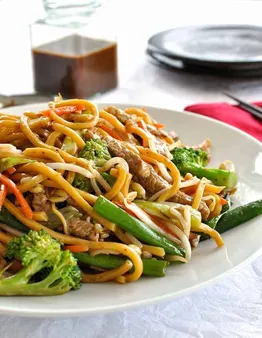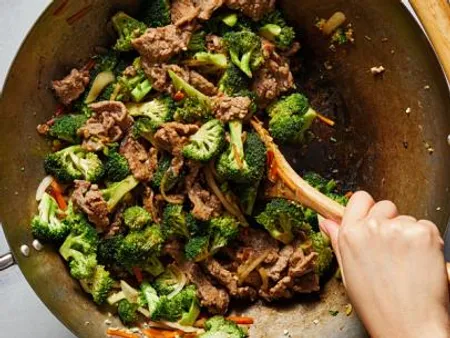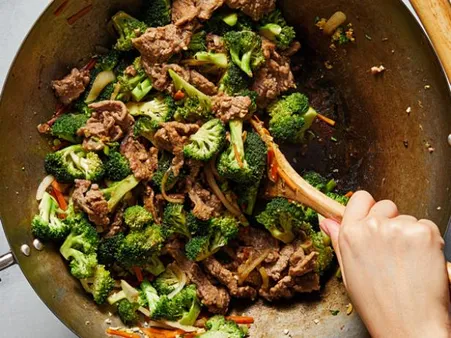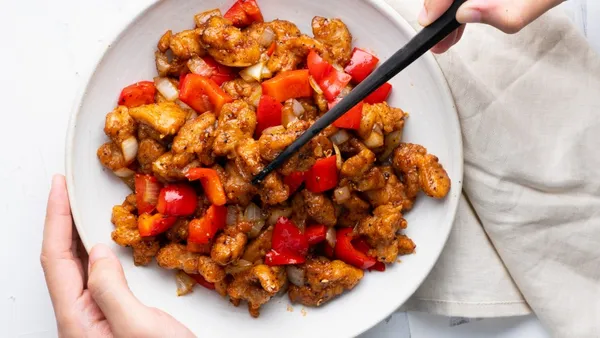Table of Contents
Unveil The secrets of Chinese stir-frying techniques with Tauhuichiban. Embark on a culinary adventure that will transform your kitchen into a vibrant symphony of flavors and aromas. Discover the intricacies of this beloved cooking technique, from the mastery of heat control to the rhythmic dance of tossing ingredients. Whether you're a novice seeking to master the basics or a seasoned cook yearning to elevate your skills, Tauhuichiban's guide will empower you with the knowledge and inspiration to create authentic and delectable stir-fried dishes that will tantalize your taste buds and leave you craving for more.

The Secrets of Chinese Stir-Frying Techniques: A Culinary Masterclass
I. The Secrets of Chinese Stir-Frying Techniques: Mastering the Wok
Stir-frying is a cherished culinary technique that originated in the energetic kitchens of China, and has since become a popular cooking method worldwide. We will unveil the secrets of Chinese stir-frying, guiding you through the equipment, ingredients, techniques, and tricks you need to master this vibrant art form, and bring authentic and delectable stir-fried dishes to your table. Explore top-rated Chinese restaurants in your city.
Unleashing the Elements of Wok Mastery: Equipment and Heat Control
The Chinese wok is the heart of stir-frying, a large, round-bottomed pan designed to achieve and maintain high temperatures, essential for searing and tossing ingredients. The right amount of heat is crucial, so having a strong heat source is key. Whether you use gas or electric, adjust the flame or heat setting to achieve intense heat for the best results. Maintaining consistent heat throughout the cooking process is equally important, as sudden temperature changes can affect the outcome of your dish.
Stir-Frying Equipment | Purpose |
|---|---|
Chinese wok | Round-bottomed pan for high-temperature cooking |
Spatula | For tossing and stirring ingredients |
Wok brush | For applying oil and sauces evenly |
Strainer or spider | For draining and removing ingredients from hot oil |
Essential Ingredients for Stir-Frying Excellence
The choice of ingredients plays a vital role in stir-frying. Fresh, high-quality vegetables, tender cuts of meat, and flavorful sauces are key. Here are some common ingredients used in Chinese stir-frying:
- Vegetables: bok choy, broccoli, carrots, celery, green beans, onions, peppers, snow peas
- Meat: beef, chicken, pork, shrimp, tofu
- Sauces: soy sauce, oyster sauce, hoisin sauce, Shaoxing wine
- Seasonings: garlic, ginger, green onions, sesame oil
Techniques for Mastering the Rhythmic Art of Stir-Frying
Stir-frying is a lively dance between the ingredients, the wok, and the cook. Mastering the technique requires practice and coordination. Here are some essential techniques to follow:
- Heat the wok over high heat and add oil.
- Add your ingredients and stir or toss constantly to prevent burning.
- Use a wok spatula or chopsticks to move ingredients around the wok.
- Do not overcrowd the wok, as this will lower the temperature and prevent even cooking.
- Cook ingredients in batches if necessary.
- Add sauces and seasonings towards the end of cooking to prevent burning.
Secrets of Flavor Revelation: Seasonings, Sauces, and Aromatics
The secret to flavorful stir-fries lies in the harmonious blend of seasonings, sauces, and aromatics. Soy sauce is a staple seasoning, adding a salty and umami flavor. Oyster sauce provides a thick, savory richness, while hoisin sauce brings a sweet and tangy note. Aromatic ingredients like garlic, ginger, and green onions enhance the overall flavor profile. Experiment with different combinations to find your preferred balance.
Aromatic Enhancements: Herbs, Spices, and Oils
Apart from the essential ingredients and sauces, herbs, spices, and oils can elevate your stir-fries to new heights. Sichuan peppercorns add a unique numbing and spicy flavor, while star anise and cinnamon provide warmth and depth. Sesame oil infuses a nutty aroma and enhances the overall taste. Use these aromatic ingredients judiciously to avoid overpowering the dish.
The Art of Wok Chi: Infusing Dishes with Depth of Flavor
Wok chi is a culinary term that refers to the essence or flavor developed in a wok. It is achieved through the proper use of heat, seasonings, and aromatics, resulting in a dish that is both flavorful and aromatic. Achieving wok chi requires practice and an intuitive understanding of the cooking process. Patience and persistence are key to harnessing this culinary art form.
Unveiling the Culinary Secrets of Stir-Frying: Tips and Tricks
To further enhance your stir-frying skills, here are some additional tips and tricks:
- Use a well-seasoned wok to achieve better heat distribution and prevent sticking.
- Marinate your meat or tofu before cooking to enhance flavor.
- Blanch vegetables before stir-frying to retain their color and texture.
- Add cornstarch to sauces for a thicker consistency.
- Do not overcook your ingredients, as they will become tough and lose their vibrant color.
A Stir-Frying Journey: Recipes for Beginners and Culinary Adventurers
Whether you are a novice cook or an experienced culinary enthusiast, our collection of stir-frying recipes has something for everyone. Discover the origins of popular Chinese dishes and embark on a culinary adventure with our beginner-friendly and adventurous recipes. From classic dishes like Beef and Broccoli to innovative culinary creations, there is something to satisfy every palate and skill level.

The Secrets of Chinese Stir-Frying Techniques: Mastering the Wok
II. Essential Ingredients for Stir-Frying Success
The foundation of any great stir-fry lies in the careful selection and preparation of its ingredients. From the tender cuts of meat to the vibrant hues of vegetables, each element plays a crucial role in creating a harmonious and flavorful dish. In this section, we will delve into the essential ingredients that will elevate your stir-fries to culinary heights.
Meat: The choice of meat for your stir-fry is a matter of personal preference and the desired texture. Popular options include chicken, beef, pork, and shrimp. For a tender and juicy result, opt for thinly sliced or cubed meat. Marinating the meat in a flavorful sauce before cooking adds an extra layer of depth and umami.
Meat | Texture | Flavor |
|---|---|---|
Chicken | Tender and juicy | Mild and versatile |
Beef | Chewy and flavorful | Rich and savory |
Pork | Tender and slightly fatty | Mild and slightly sweet |
Shrimp | Tender and succulent | Sweet and briny |
Vegetables: The vibrant colors and textures of vegetables add visual appeal and nutritional value to your stir-fries. Choose a variety of vegetables that complement each other in terms of flavor and cooking time. Some popular choices include broccoli, carrots, bell peppers, onions, and mushrooms. Blanching the vegetables briefly before stir-frying helps preserve their crispness and color.
- Broccoli: Adds a bright green color and a slightly bitter flavor.
- Carrots: Provide sweetness and a vibrant orange hue.
- Bell peppers: Offer a variety of colors and a mild, slightly sweet flavor.
- Onions: Add a savory base and a hint of sweetness.
- Mushrooms: Contribute an earthy flavor and a meaty texture.
Sauce: The sauce is the heart and soul of any stir-fry, bringing together all the flavors and textures. A well-balanced sauce should be flavorful, slightly thickened, and complement the ingredients without overpowering them. Common ingredients used in stir-fry sauces include soy sauce, oyster sauce, hoisin sauce, and rice vinegar. Experiment with different sauces to find the ones that suit your taste preferences.
Seasonings: Seasonings play a vital role in enhancing the flavors of your stir-fry. A combination of salt, pepper, garlic, and ginger forms the foundation of many stir-fry dishes. Other popular seasonings include chili flakes, sesame oil, and Chinese five-spice powder. Adjust the seasonings to your liking, keeping in mind that a little goes a long way.
By carefully selecting and preparing your ingredients, you lay the groundwork for a successful and flavorful stir-fry. Remember to consider the texture, flavor, and cooking time of each ingredient to create a harmonious and satisfying dish.

Essential Ingredients for Stir-Frying Success
III. Techniques for Perfect Stir-Frying
Stir-frying is a cooking method that originated in China over 2,000 years ago. It is a quick and easy way to cook food, and it is a popular choice for busy families. However, stir-frying can be tricky to master. Heat, speed, and timing are all critical to achieving the perfect stir-fry. Also vital is the vessel in which you cook. Woks, a traditional round-bottomed Chinese cooking pan, have a large surface area that allows for quick cooking over high heat. If you do not have a wok, you may stir-fry just as easily in a large skillet.
Before you start stir-frying, it is essential to prep all of your ingredients. This means washing, peeling, and chopping your vegetables, and cutting your meat into bite-sized pieces. Once your ingredients are prepped, follow these steps to stir-fry like a pro:
- Heat your wok or skillet over high heat. Add a little oil, and swirl to coat the pan.
- Add your meat to the pan and stir-fry until it is cooked through.
- Add your vegetables to the pan and stir-fry until they are cooked to your desired tenderness.
- Add your sauce and stir-fry until the sauce is heated through.
- Serve immediately over rice or noodles.
Here is your wok vs skillet table. Which is better for stir-frying?
| Feature | Wok | Skillet |
|---|---|---|
Shape | Round bottom, flared sides | Flat bottom, straight sides |
Material | Typically carbon steel or cast iron | Typically stainless steel or cast iron |
Heat distribution | Excellent | Good |
Heat retention | Excellent | Good |
Versatility | Can be used for a variety of cooking methods, including stir-frying, deep-frying, steaming, and braising | Best suited for stir-frying and searing |

Techniques for Perfect Stir-Frying
IV. Common Mistakes to Avoid
Overcrowding the Wok
When stir-frying, it's important to avoid overcrowding the wok. This will prevent the ingredients from cooking evenly and can result in soggy or undercooked food. Instead, cook the ingredients in batches, adding more as the previous batch is cooked.
Using the Wrong Heat
The heat of the wok is crucial for successful stir-frying. The wok should be heated over high heat until it is smoking hot. This will help to sear the ingredients and prevent them from sticking. If the wok is not hot enough, the ingredients will steam rather than fry, resulting in a less flavorful dish.
Not Using Enough Oil
Oil is essential for stir-frying, as it helps to prevent the ingredients from sticking to the wok and allows them to brown evenly. Be sure to use a high-heat oil, such as canola oil or peanut oil. Avoid using olive oil, as it has a low smoke point and can burn easily.
Stirring Too Frequently
When stir-frying, it's important to stir the ingredients frequently, but not too frequently. Stirring too frequently can break up the ingredients and prevent them from browning properly. Instead, stir the ingredients just enough to keep them from sticking to the wok.
Overcooking the Ingredients
Stir-frying is a quick-cooking method, so it's important to avoid overcooking the ingredients. Overcooked ingredients will become tough and chewy. Instead, cook the ingredients just until they are tender and cooked through.

Common Mistakes to Avoid
V. Conclusion
As you venture deeper into the realm of Chinese stir-frying, remember that practice and experimentation are key. Embrace the learning process, and don't be afraid to experiment with different ingredients, flavors, and techniques. The more you engage with this culinary art form, the more you will refine your skills and create dishes that showcase your unique culinary flair. So seize your wok, ignite the flames, and delve into the vibrant and rewarding world of Chinese stir-frying. Your taste buds will thank you for it, and your culinary horizons will expand beyond measure.